Abstract
In this work, a generalized algorithm is introduced to generate all alternatives of planar N-bar kinematic chains (KCs) with simple joints containing sliders. A simple graphical technique is introduced to enumerate all available N-bar chains with prismatic (P) joints. Then, a new topological Loop Code (TLC) is presented to detect isomorphic chains during the enumeration process in addition to detecting rejected KCs. A visual C++ code is developed for automatic enumeration and detection of rejected KCs and isomorphic KCs. Examples of 6, 8, and 10-bar KCs are presented to illustrate algorithm procedures. As a result, 21, 16, and 1350 KCs have P-joints for Stephenson, Watt, and 8-bar chains, respectively. Also, 308 KCs are obtained for a 10-bar KC with up to 3 sliders.
1. Introduction
Over the past five decades, the structural synthesis of KCs has been an important topic in mechanism design. Enumeration of KCs helps to analyze their characteristics and to select a proper chain for a purpose. Many researchers have proposed graph theory as an effective method to generate and evaluate KCs. Isomorphism detection is an essential stage in the structural synthesis of planar mechanisms to ensure that all configurations of a KC are distinct. However, the generation of KCs containing prismatic pairs has a little work in mechanism research.
Generally, the structural synthesis of KCs, with P-pairs, has been studied by few researchers. A split hamming string was used as a test for isomorphism in KCs with P-joints by Dharanipragada [1]. A computer program was developed to test the isomorphism of single-Degree of Freedom (DOF) simple-jointed planar 6-bar KCs up to seven P-joints and 8-bar KCs up to ten P-joints.
A novel technique of double-springs was introduced by Kang et al. [2] to attach a finite number of ground rectangular rigid blocks. Revolute joints and P-pairs were used by Mitsi et al. [3,4,5] in position analysis of the Assur group. Therefore, all configurations of the Assur group were presented. Configurations of 5-task positions were proposed by Myszka and Murray [6] for a 1-dimensional set of (R-P) dyads used in design by a P-pair. A method to generate available planar mechanisms with R and P-pairs was presented by Martin [7]. Then a new technique for P-joint assignment was introduced. Eleashy [8] introduced a joint sorting code to enumerate all KCs containing P-joints of 8-bar chains.
Structural synthesis of KCs, with R-pairs, has been studied by many researchers including the generation of KCs as well as the isomorphism identification process. A direct technique for the detection of n-link KCs from (n − 2)-link linkage using the hamming number technique was introduced by Rao [9]. Rao et al. [10] introduced a new method that did not need an isomorphism check by loop assortment and matrix representation. The theory of loop analysis was implemented for isomorphism identification of KCs by Ding and Huang [11]. Unified planar linkages were introduced by Kim et al. [12,13] to formulate the synthesis problem as an iterative design optimization problem. Nie et al. [14] proposed an additional technique with two links and three pairs for generation of closed linkages. This technique was used to generate all KCs with up to 12 links. A complete atlas database of 2-DOF KCs up to 15 links was established by Ding et al. [15] using graph-based representation. Based on link assortments and graph theory, Yan and Chiu [16] established several atlases of linkage chains. Ding et al. [17,18] introduced a generalized technique for the generation of closed-loop 3DOF chains with multiple joints. Then, a complete database for closed-loop KCs with 3 DOF was introduced.
Yan and Chiu [19] improved the cut-links and the non-planar graph-checking algorithms to construct KCs. Then, the database of KCs was introduced up to 16 links. Many techniques were presented to solve an isomorphism problem based on numerical and optimization methods. An algorithm was presented by Ding et al. [20,21] to get a characteristic number string of topological graphs with 2-multiple joints that improve the isomorphism detection process. Then, the whole set of non-fractionated simple-joint KCs with up to 19 links was developed. Isomorphism identification has been introduced in many papers. A computer-aided technique was proposed by Yang and Ding [22] to generate the non-isomorphic planar KCs from the associated non-fractionated simple-joint KCs. Agrawal and Rao [23] introduced a matrix representation of KCs to introduce a unique expression for a KC.
A genetic algorithm (GA) was introduced by Yang et al. [24] to detect the isomorphism of KCs. Hasan et al. [25] presented a new technique to check the isomorphic chains using joint–joint matrices. Pucheta and Cardona [26] developed a new method, based on graph theory and combinatorial analysis, to detect isomorphism among KCs. Concepts of perimeter loop, maximum perimeter degree sequence, and perimeter topological graph were introduced by Ding and Huang [27,28,29] to test isomorphic chains. Then, a complete atlas of KCs was presented. A simplified formulation of the isomorphism detection process was developed by Marin et al. [30] using a neural network. A dividing and matching algorithm was proposed by Zeng et al. [31] to detect the isomorphism using the adjacency matrix of KC and changing the order of vertices. Singh [32] used the hamming method to perform an isomorphism check among planar KCs. Kamesh et al. [33] introduced the concept of net distance as a quantitative measure to detect isomorphic chains. Applications of P-joint have been investigated by Wang and Marco [34] in three-DOF translational parallel manipulators. Yang et al. [35] presented a new algorithm based on the parameters of degree, weight, degree sequence, and weight sequence to detect isomorphism for kinematic chains with up to four P-pairs and up to 14 links.
Therefore, little work has been introduced in this field including graphical and numerical methods. These methods were applied to specific types of KCs containing particular numbers of P-joints. In this paper, an improved, generalized, and simplified method, based on graphical approach, is presented using visual C++ code to enumerate all solutions of non-isomorphic planar KCs containing 1–3 sliders, where chains with 1–3 sliders are most essentially applied in practice. The proposed method can be applied to any planar KCs with any number of P-joints.
2. Algorithm Procedures
The proposed method depends mainly on a simple graphical approach. All procedures can be summarized in the flow chart shown in Figure 1a.

Figure 1.
(a) Proposed algorithm flow chart. (b) Example for a 10-bar kinematic chain with 3-DOF.
2.1. Identification of Independent Loops
A simple joint is formed when two links are connected, whereas multiple joints are formed when more than two links are connected. Considering simple-joint KCs, given N-bar, KC initially has R-joints. Assignment of P-joints depends mainly on the structural characteristics of a KC. Therefore, mechanism topology should be identified including the number and type of both links and joints. As indicated in [36], the total number of independent loops in a KC is given by:
where: x: number of loops (independent and peripheral loop)
N: number of links
f: Degree of Freedom (DOF)
For the 10-bar KC shown in Figure 1, it has 3-DOF and four independent loops: namely L1, L2, L3, and Lp as a peripheral loop.
2.2. Generation of KCs with Sliders
All KCs are initially represented using revolute joints. Then some of these R-joints will be replaced by sliding joints. A graphical representation is applied to represent the initial KC and to enumerate all solutions of adding 1, 2, or 3 P-joints instead of R-joints. A visual C++ code is constructed to explore all available configurations for a certain KC. R-joints are represented as circles and P-joints are represented as rectangles. For Watt chain, all solutions of adding 2-sliders are presented in Figure 2 as each graph should contain only 2 P-joints by iteration method.
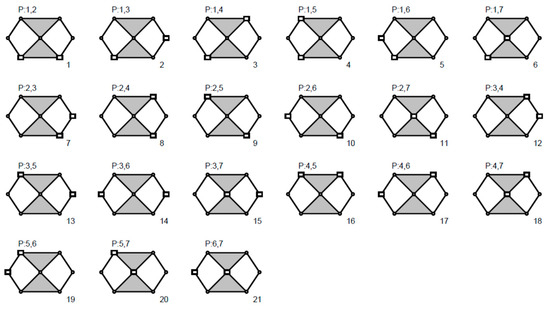
Figure 2.
Available configuration for Watt chain with 2 sliders.
2.3. Deriving Initial Topological Loop Code (ITLC)
Initial topological loop code (ITLC) is introduced to represent each loop in a considered KC. Each loop in a KC is analyzed to identify types of links and joints. Now, each loop may contain R-joints and P-joints. ITLC can be derived for such a loop as follows:
- 1-
- Each loop has a corresponding matrix ITLC1×n = [M1, M2, M3, …, Mn](Where: n represents the number of pairs in the considered loop), i.e., each joint is represented as an element, Mi, in the ITLC.
- 2-
- Each element, Mi, has three digits. (Lx Ly Jt)Lx: refers to the type of the first link of a considered pair, Ly: refers to the type of the second link of the considered pair and Jt: refers to the type of pair.
- 3-
- Values of Lx Ly and Jt are indicated as follows:
- 4-
- Lx, Ly are sorting in ascending order.
According to Figure 3a, links A and B are connected by R-joint, so that joint ‘1’ can be represented by an element M1 = 230. Figure 3b illustrates joint ‘2’ that connects links C and D by a P-joint, so that joint ‘2’ can be represented by an element M2 = 341.
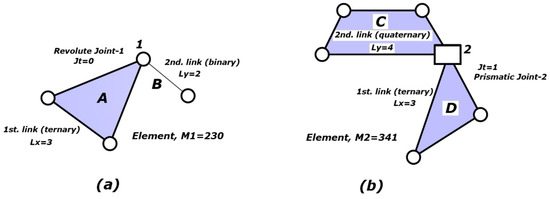
Figure 3.
Deriving Initial topological loop code, ITLC. (a) Joint between binary and ternary links. (b) Joint between quaternary and ternary links.
Considering a 10-bar KC, shown in Figure 4a, loop-1 has four joints (7, 12, 13, 6). Links J and A are connected by R-joint ‘7’ which has a corresponding element of M7 = 240. Links F and H are connected by R-joint ‘5’ which has a corresponding element of M5 = 331. Links C and A are connected by P-joint ‘8’ which has a corresponding element of M8 = 241.…etc.
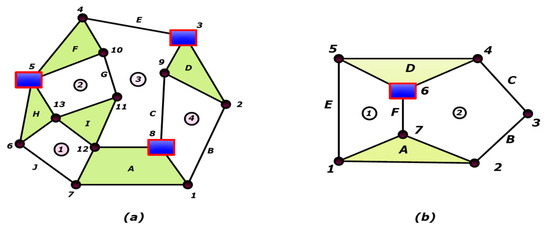
Figure 4.
(a) 10-bar single-DOF KC with 3-prismatic joints. (b) Stephenson KC with 1-prismatic joint.
2.4. Improving Topological Loop Code (TLC)
An improved topological loop code (TLC) can be generated for each loop by rearranging elements of ITLC in a specific order according to joints priorities. Generally, TLC can be generated as follows:
- 1-
- Vi, Elements of TLC, can be derived by resorting elements of ITLC starting from the lowest element.
- 2-
- Each loop will be represented by a matrix TLC 1×n = [V1, V2, V3, …, Vn]
- 3-
- The second element is the minimum element adjacent to the first element.
- 4-
- The second element indicates the sorting direction of other elements even clockwise or anticlockwise.
- 5-
- If there is more than one element that has the lowest value, the first element will be selected such that the maximum number of consequent lowest elements is achieved.
- 6-
- If close adjacent elements to the first element are equal, the sorting direction is identified according to the next adjacent elements on both sides.
Loop-1, in Stephenson KC shown in Figure 4b, has three joints 1, 5, 7 of the same value M = 230. Hence, the sorting direction will be clockwise starting with joint-7. Therefore, loop joints sorting will be (7-1-5-6). Sorting also can start with joint 5 in an anticlockwise direction. In loop-2, joint-3 connects two binary links i.e., it has the higher priority with M3 = 220. The nearest joints (4, 2) have the same priority with M2 = M4= 230. If the consequent joints (6, 7) are compared, joint-7 has a higher priority with M7 = 230. Therefore, the direction of sorting is clockwise starting with joint-3 and joint sorting will be (3-2-7-6-4).
2.5. Generation of KC Topological Matrix (KCTM)
A KC will be introduced by a new topological matrix KCTM. Each row in this matrix refers to TLC for a corresponding loop. Please note that missing elements will be denoted as zero value.
3. Example: Generation of 10-Bar Chains with 3-Sliders
Starting from a single-DOF 10-bar chain, it is necessary to enumerate all the available chains with 3-sliders. Then ITLC, TLC, and KCTM will be generated.
3.1. P-Joints Assignment
A single-DOF 10-bar chain has 13 revolute joints as indicated in Figure 4a. For the assignment of 3P-joints to a 10-bar chain, there will be 286 available configurations. Using the developed VC++ code, all configurations are enumerated automatically as shown in Figure 5. Each configuration has a notation of P-joint labels that have been transformed from revolute into P-joints.

Figure 5.
Some available configurations of 10-bar chains with 3P-joints.
3.2. Generation of ITLC and TLC and KCTM for 10-Bar KC
Considering the 10-bar KC shown in Figure 4a, ITLC and TLC and KCTM can be derived. First, the KC has 5 loops according to Equation (1).
The following steps illustrate how to generate the proposed codes
- 1-
- Loop-1 consists of 4 links: A, I, H, and J
- 2-
- These link types are quaternary, ternary, ternary and binary links, respectively.
- 3-
- 4 joints connecting these links: all are revolute joints.
- 4-
- So that; ITLC (for loop-1) = [240, 340, 330, 230]
- 5-
- Joint-6 has the higher priority with M6 = 230. Joint-7 has the 2nd priority with M7 = 240. Hence, joint sorting is 6-7-12-13 with an anticlockwise direction.
- 6-
- Therefore, TLC can be derived by resorting ITLC in step 4 to start with M6. Hence, TLC (for loop-1) = [230, 240, 340, 330].
- 7-
- TLC for all loops can be derived as shown in Figure 6.
 Figure 6. Generation of ITLC and TLC and KCTM for 10-bar chain in Figure 4a.
Figure 6. Generation of ITLC and TLC and KCTM for 10-bar chain in Figure 4a. - 8-
- A VC++ code is developed to obtain TLC for all enumerated KCs as shown in Figure 7.
 Figure 7. Some available configurations of 10-bar chain with their codes.
Figure 7. Some available configurations of 10-bar chain with their codes.
4. Isomorphism Detection Using KCTM
Two structures are said to be isomorphic if there is a one-to-one correspondence of links and joints of two structures. These KCs must be eliminated from enumeration results. Using the proposed technique, isomorphic KCs have the same KCTM regardless of their row order.
Two Stephenson KCs as shown in Figure 8 initially have different configurations. However, it can be investigated that each row in KCTM of left side KC has a matching row in the KCTM on the right-side KC. Hence, both KCs are isomorphic. Detection of all isomorphic KCs is automatically achieved using the established VC++ code. It has been applied successfully for isomorphism identification of Watt, Stephenson, all 8-bar chains, and a 10-bar chain containing up to 3 sliders. Figure 9 illustrates results for detecting isomorphic KCs of Stephenson chain containing 3P-joints. The constructed VC ++ code can detect that the 11th and 24th KCs are isomorphic.
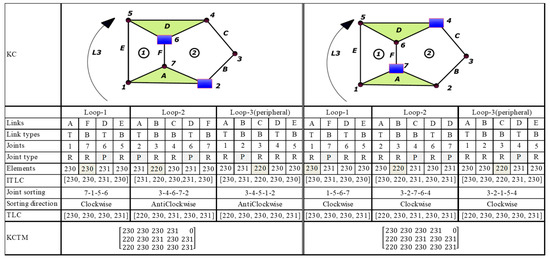
Figure 8.
Generation of ITLC, TLC, KCTM for Stephenson 6-chain.
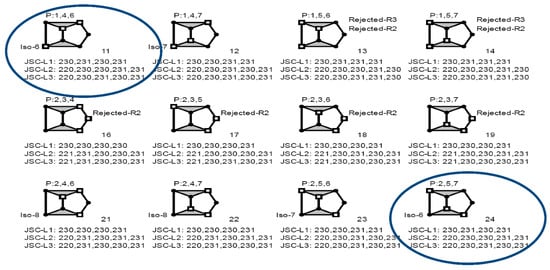
Figure 9.
Generation of isomorphic and rejected KCs of Stephenson chain containing 3P-joints.
5. Check for Rejected Chains Using TLC
During the enumeration process, the assignment of P-joints should take into consideration three rules introduced by [7]:
- R1-No link of a chain can contain only P-pairs which directions are parallel.
- R2-Binary links of a chain with only P-pairs cannot be connected directly.
- R3-No closed circuit of a chain can have less than two R-pairs.
All generated graphs must be evaluated according to these rules. The proposed TLC is an efficient tool to detect and eliminate graphs that do not agree with the previous rules as follows:
Case 1.
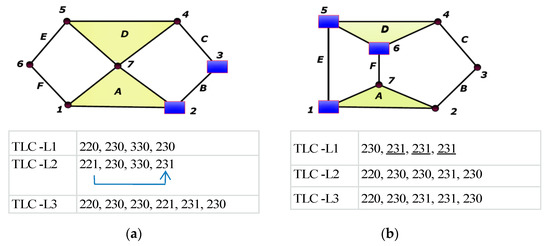
A KC is said to be rejected due to R2 if two consecutive elements for any loop have:
Lx or Ly = 2 (i.e., a binary link is connected) and Jt = 1 (i.e., a P-pair is attached)
For example, Figure 10a illustrates Watt chain with two prismatic joints. A binary link B is attached to links A and C by prismatic joints. This arrangement disagrees with rule R2. Using the generated TLC for loop-2, two consecutive elements have Lx = 2 and Jt = 1.

Figure 10.
(a) Watt chain with 2 sliders (b) Stephenson chain with 3 sliders.
Case 2.
A KC is said to be rejected due to R3 if there are (n − 1) elements, for a given loop, with Jt = 1. (i.e., loop has n-elements with (n − 1) P-joints). Loop-1 in the Stephenson chain, shown in Figure 10b, has four elements and three sliders. However, it should contain two R-joints at least.
The established VC ++ code is applied effectively to detect all rejected graphs. Figure 9 illustrates some rejected KCs for the Stephenson chain containing 3-sliders such as 16th and 17th chains which are rejected due to R2. However, 14th and 19th chains are rejected due to R2 and R3 as well.
6. Results
A general algorithm is presented to obtain an atlas of N-bar KCs containing sliders. The proposed algorithm has been applied successfully to generate an atlas of 6-bar and 8-bar chains with up to 3 sliders. Rules of adding prismatic joints introduced by [7] are considered. Therefore, some results are not coincident with [1]. The developed technique produces 37 and 1350 non-isomorphic KCs for 6-bar and 8-bar chains, respectively. The presented algorithm is also used to generate KCs with up to 3-sliders of a 10-bar chain for the first time. This produces 13, 73, and 222 KCs with 1, 2, and 3-sliders, respectively. Detailed results for 6-bar and 10-bar chains are presented in Table 1. Brief results of the proposed algorithm and other literature are shown in Table 2. Atlases of Stephenson chain containing 1, 2, and 3 sliders are shown in Figure 11. Atlases of Watt chain with 1, 2, and 3-sliders are shown in Figure 12. Some non-isomorphic 10-bar KCs with 1, 2, and 3-sliders are shown in Figure 13.

Table 1.
Results of the generation of 6-bar and 10-bar KCs with 1,2 and 3 sliders.

Table 2.
Brief results of the proposed algorithm and other literature.

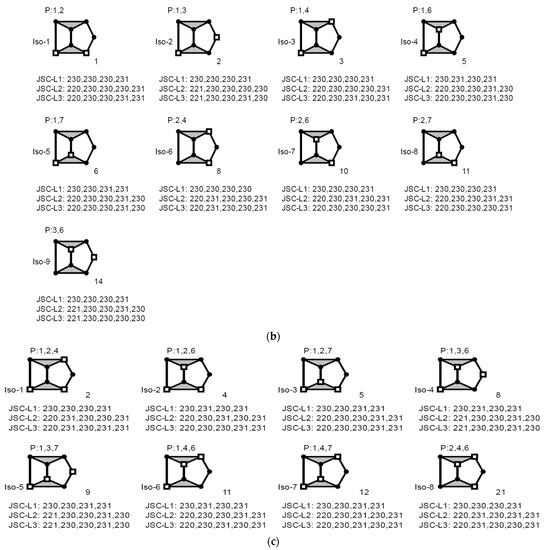
Figure 11.
(a). Atlas of Stephenson chain with 1-slider. (b). Atlas of Stephenson chain with 2-sliders. (c). Atlas of Stephenson chain with 3-sliders.
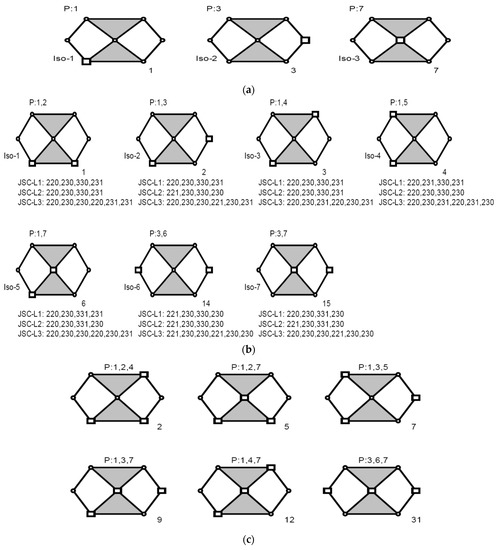
Figure 12.
(a). Atlas of Watt chains with 1-slider. (b). Atlas of Watt chain with 2-sliders. (c). Atlas of Watt chain with 3-sliders.
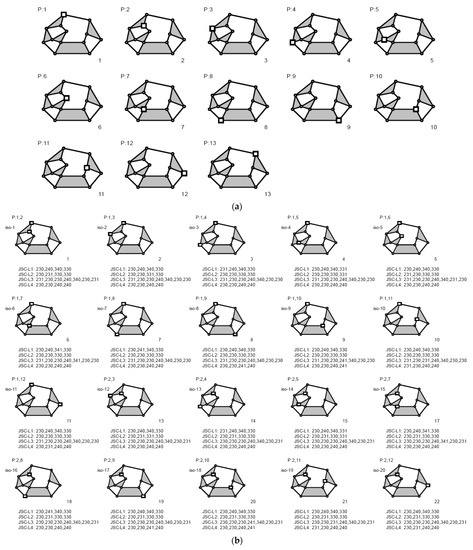
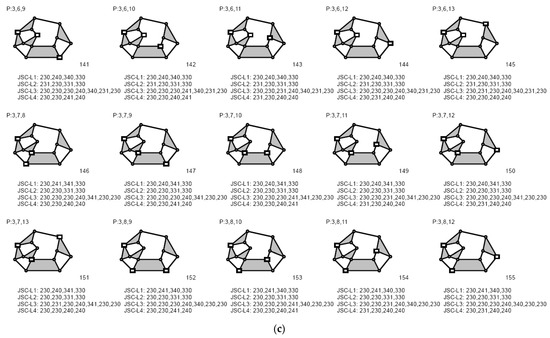
Figure 13.
(a) Atlas of a 10-bar chain with 1-slider. (b) Some results of a 10-bar chain with 2-sliders. (c) Some results of a 10-bar chain with 3-sliders.
7. Conclusions
A general algorithm, based on graphical technique, is introduced to produce all alternatives of N-bar KCs with sliders. A topological loop code (TLC) and a kinematic chain topological matrix (KCTM) have been introduced as new concepts to enhance the generation process as well as to identify isomorphic KCs and rejected KCs. All procedures of the generation process are totally computerized using a VC++ code. The proposed algorithm is applied to enumerate all solutions of a 6-bar, 8-bar, and 10-bar chain with simple joints. The proposed method can be applied for any planar KC.
Author Contributions
Conceptualization, M.H., J.W.H. and H.E.; methodology, M.H., J.W.H. and H.E.; software, M.H. and H.E.; validation, M.H., J.W.H. and H.E.; formal analysis, M.H. and H.E.; investigation, M.H., J.W.H. and H.E.; resources, M.H. and H.E.; data curation, M.H. and H.E.; writing—original draft preparation, M.H. and H.E.; writing—review and editing, M.H., J.W.H. and H.E.; visualization, M.H., J.W.H. and H.E.; supervision, M.H. and H.E.; project administration, M.H., J.W.H. and H.E.; funding acquisition, M.H., J.W.H. and H.E. All authors have read and agreed to the published version of the manuscript.
Funding
This research was supported by a grant (19CTAP-C152266-01) from Technology Advancement Research Program (TARP) funded by Ministry of Land, Infrastructure and Transport of Korean government.
Institutional Review Board Statement
Not applicable.
Informed Consent Statement
Not applicable.
Data Availability Statement
Not applicable.
Acknowledgments
The authors are grateful to Taif University (Taif, KSA), Mansoura University (Mansoura, Egypt) and Future University in Egypt (Cairo, Egypt) for providing all the required facilities to carry out the present research.
Conflicts of Interest
The authors declared no conflict of interest.
Abbreviations
The following abbreviations are used in this manuscript:
| KCs | kinematic chains |
| KCTM | kinematic chain topological matrix |
| TLC | Topological loop code |
| ITLC | Initial topological loop code |
| DOF | Degree of freedom |
| GA | Genetic algorithm |
References
- Dharanipragada, V.; Chintada, M. Split Hamming String as an Isomorphism Test for One Degree-of-Freedom Planar Simple-Jointed Kinematic Chains Containing Sliders. J. Mech. Des. 2016, 138, 082301. [Google Scholar] [CrossRef]
- Kang, S.W.; Kim, S.I.; Kim, Y.Y. Topology optimization of planar linkage systems involving general joint types. Mech. Mach. Theory 2016, 104, 130–160. [Google Scholar] [CrossRef]
- Mitsi, S.; Bouzakis, K.-D.; Mansour, G.; Popescu, I. Position analysis in polynomial form of planar mechanisms with Assur groups of class 3 including revolute and prismatic joints. Mech. Mach. Theory 2003, 38, 1325–1344. [Google Scholar] [CrossRef]
- Mitsi, S.; Bouzakis, K.-D.; Mansour, G. Position analysis in polynomial form of planar mechanism with an Assur group of class 4 including one prismatic joint. Mech. Mach. Theory 2004, 39, 237–245. [Google Scholar] [CrossRef]
- Mitsi, S.; Bouzakis, K.-D.; Mansour, G.; Popescu, I. Position analysis in polynomial form of class-three Assur groups with two or three prismatic joints. Mech. Mach. Theory 2008, 43, 1401–1415. [Google Scholar] [CrossRef]
- Myszka, D.H.; Murray, A.P. Pole arrangements that introduce prismatic joints into the design space of four- and five-position rigid-body synthesis. Mech. Mach. Theory 2010, 45, 1314–1325. [Google Scholar] [CrossRef]
- Pucheta, M.A.; Cardona, A. Type Synthesis of planar Linkage Mechanisms with Rotoidal and Prismatic Joints. Mecánica Comput. Novemb. 2005, XXIV, 2703–2730. [Google Scholar]
- Eleashy, H. A new atlas for 8-bar kinematic chains with up to 3 prismatic pairs using Joint Sorting Code. Mech. Mach. Theory 2018, 124, 118–132. [Google Scholar] [CrossRef]
- Rao, A. Hamming number technique—II. Generation of planar kinematic chains. Mech. Mach. Theory 1997, 32, 489–499. [Google Scholar] [CrossRef]
- Rao, A.; Deshmukh, P.B. Computer aided structural synthesis of planar kinematic chains obviating the test for isomorphism. Mech. Mach. Theory 2001, 36, 489–506. [Google Scholar] [CrossRef]
- Ding, H.; Huang, Z. A new theory for the topological structure analysis of kinematic chains and its applications. Mech. Mach. Theory 2007, 42, 1264–1279. [Google Scholar] [CrossRef]
- Kim, Y.Y.; Jang, G.-W.; Park, J.H.; Hyun, J.S.; Nam, S.J. Automatic Synthesis of a Planar Linkage Mechanism With Revolute Joints by Using Spring-Connected Rigid Block Models. J. Mech. Des. 2006, 129, 930–940. [Google Scholar] [CrossRef]
- Jang, G.-W.; Nam, S.J.; Kim, Y.Y. A Modified Formulation for Automatic Synthesis of Planar Linkage Mechanisms. In Proceedings of the 11th International Power Transmission and Gearing Conference, Washington, DC, USA, 1–3 September 2011. [Google Scholar]
- Nie, S.; Liao, A.; Qiu, A.; Gong, S. Addition method with 2 links and 3 pairs of type synthesis to planar closed kinematic chains. Mech. Mach. Theory 2012, 58, 179–191. [Google Scholar] [CrossRef]
- Ding, H.; Cao, W.; Kecskeméthy, A.; Huang, Z. Complete Atlas Database of 2-DOF Kinematic Chains and Creative Design of Mechanisms. J. Mech. Des. 2012, 134, 031006. [Google Scholar] [CrossRef]
- Yan, H.-S.; Chiu, Y.-T. An algorithm for the construction of generalized kinematic chains. Mech. Mach. Theory 2013, 62, 75–98. [Google Scholar] [CrossRef]
- Ding, H.; Yang, W.; Huang, P.; Kecskeméthy, A. Automatic Structural Synthesis of Planar Multiple Joint Kinematic Chains. J. Mech. Des. 2013, 135, 091007. [Google Scholar] [CrossRef]
- Ding, H.; Huang, P.; Liu, J.; Kecskeméthy, A. Automatic Structural Synthesis of the Whole Family of Planar 3-Degrees of Freedom Closed Loop Mechanisms. J. Mech. Robot. 2013, 5, 041006. [Google Scholar] [CrossRef]
- Yan, H.-S.; Chiu, Y.-T. An improved algorithm for the construction of generalized kinematic chains. Mech. Mach. Theory 2014, 78, 229–247. [Google Scholar] [CrossRef]
- Ding, H.; Yang, W.; Zi, B.; Kecskeméthy, A. The family of planar kinematic chains with two multiple joints. Mech. Mach. Theory 2016, 99, 103–116. [Google Scholar] [CrossRef]
- Ding, H.; Huang, P.; Yang, W.; Kecskeméthy, A. Automatic generation of the complete set of planar kinematic chains with up to six independent loops and up to 19 links. Mech. Mach. Theory 2016, 96, 75–93. [Google Scholar] [CrossRef]
- Ding, H.; Hou, F.; Kecskeméthy, A.; Huang, Z. Synthesis of a complete set of contracted graphs for planar non-fractionated simple-jointed kinematic chains with all possible DOFs. Mech. Mach. Theory 2011, 46, 1588–1600. [Google Scholar] [CrossRef]
- Agrawal, V.; Rao, J. Identification and isomorphism of kinematic chains and mechanisms. Mech. Mach. Theory 1989, 24, 309–321. [Google Scholar] [CrossRef]
- Yang, P.; Zeng, K.; Li, C.; Yang, J.; Wang, S. An improved hybrid immune algorithm for mechanism kinematic chain isomorphism identification in intelligent design. Soft Comput. 2014, 19, 217–223. [Google Scholar] [CrossRef]
- Hasana, A.; Khanb, R.; Mohdc, A. A new method to detect isomorphism in kinematic chains. Kathmandu Univ. J. Sci. Eng. Technol. 2007, 1, 3. [Google Scholar]
- Pucheta, M.; Cardona, A. An automated method for type synthesis of planar linkages based on a constrained subgraph isomorphism detection. Multibody Syst. Dyn. 2007, 18, 233–258. [Google Scholar] [CrossRef]
- Ding, H.; Huang, Z. The Establishment of the Canonical Perimeter Topological Graph of Kinematic Chains and Isomorphism Identification. J. Mech. Des. 2006, 129, 915–923. [Google Scholar] [CrossRef]
- Ding, H.; Huang, Z. Loop theory and applications to some key problems of kinematic structure of kinematic chains. Front. Mech. Eng. China 2009, 4, 276–283. [Google Scholar] [CrossRef]
- Ding, H.; Huang, Z. Isomorphism identification of graphs: Especially for the graphs of kinematic chains. Mech. Mach. Theory 2009, 44, 122–139. [Google Scholar] [CrossRef]
- Galán-Marín, G.; López-Rodríguez, D.; Mérida-Casermeiro, E. A New Multivalued Neural Network for Isomorphism Identification of Kinematic Chains. J. Comput. Inf. Sci. Eng. 2010, 10, 011009. [Google Scholar] [CrossRef]
- Zeng, K.; Fan, X.; Dong, M.; Yang, P. A fast algorithm for kinematic chain isomorphism identification based on dividing and matching vertices. Mech. Mach. Theory 2014, 72, 25–38. [Google Scholar] [CrossRef]
- Saini, I.; Singh, V.P. Identification of Isomorphism in Nine Links Two Degree of Freedom Kinematic Chains Using Hamming Method. J. Inst. Eng. (India) Ser. C 2016, 97, 437–440. [Google Scholar] [CrossRef]
- Kamesh, V.V.; Rao, K.M.; Rao, A.B.S. An Innovative Approach to Detect Isomorphism in Planar and Geared Kinematic Chains Using Graph Theory. J. Mech. Des. 2017, 139, 122301. [Google Scholar] [CrossRef]
- Wang, M.; Ceccarelli, M. Topology Search of 3-DOF Translational Parallel Manipulators with Three Identical Limbs for Leg Mechanisms. Chin. J. Mech. Eng. 2015, 28, 666–675. [Google Scholar] [CrossRef]
- Yang, W.; Ding, H.; Kecskeméthy, A. Automatic synthesis of plane kinematic chains with prismatic pairs and up to 14 links. Mech. Mach. Theory 2019, 132, 236–247. [Google Scholar] [CrossRef]
- Medapati, S.R.; Kuchibhotla, M.R.; Annambhotla, B.S.R. A Novel Algorithm for the Generation of Distinct Kinematic Chain. J. Inst. Eng. (India) Ser. C 2016, 99, 261–270. [Google Scholar] [CrossRef]
Publisher’s Note: MDPI stays neutral with regard to jurisdictional claims in published maps and institutional affiliations. |
© 2021 by the authors. Licensee MDPI, Basel, Switzerland. This article is an open access article distributed under the terms and conditions of the Creative Commons Attribution (CC BY) license (https://creativecommons.org/licenses/by/4.0/).